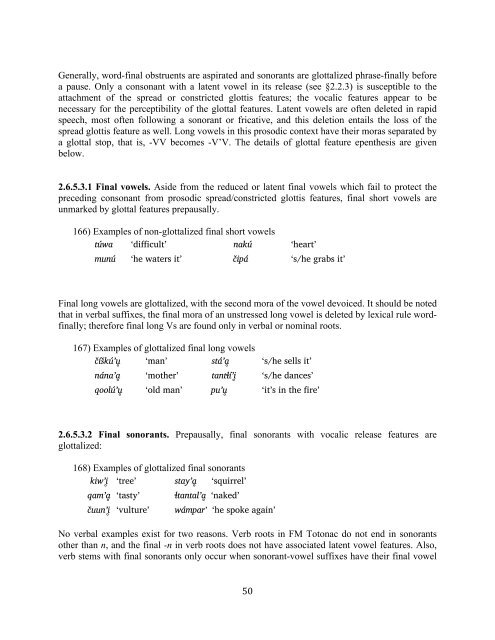The phonology and morphology of Filomeno Mata Totonac
The phonology and morphology of Filomeno Mata Totonac
The phonology and morphology of Filomeno Mata Totonac
You also want an ePaper? Increase the reach of your titles
YUMPU automatically turns print PDFs into web optimized ePapers that Google loves.
Generally, word-final obstruents are aspirated <strong>and</strong> sonorants are glottalized phrase-finally before<br />
a pause. Only a consonant with a latent vowel in its release (see §2.2.3) is susceptible to the<br />
attachment <strong>of</strong> the spread or constricted glottis features; the vocalic features appear to be<br />
necessary for the perceptibility <strong>of</strong> the glottal features. Latent vowels are <strong>of</strong>ten deleted in rapid<br />
speech, most <strong>of</strong>ten following a sonorant or fricative, <strong>and</strong> this deletion entails the loss <strong>of</strong> the<br />
spread glottis feature as well. Long vowels in this prosodic context have their moras separated by<br />
a glottal stop, that is, -VV becomes -V’V. <strong>The</strong> details <strong>of</strong> glottal feature epenthesis are given<br />
below.<br />
2.6.5.3.1 Final vowels. Aside from the reduced or latent final vowels which fail to protect the<br />
preceding consonant from prosodic spread/constricted glottis features, final short vowels are<br />
unmarked by glottal features prepausally.<br />
166) Examples <strong>of</strong> non-glottalized final short vowels<br />
túwa ‘difficult’ nakú ‘heart’<br />
munú ‘he waters it’ c%ipá ‘s/he grabs it’<br />
Final long vowels are glottalized, with the second mora <strong>of</strong> the vowel devoiced. It should be noted<br />
that in verbal suffixes, the final mora <strong>of</strong> an unstressed long vowel is deleted by lexical rule wordfinally;<br />
therefore final long Vs are found only in verbal or nominal roots.<br />
167) Examples <strong>of</strong> glottalized final long vowels<br />
c%ís%kú’u& ‘man’ stá’a& ‘s/he sells it’<br />
nána’a& ‘mother’ tant"í’i& ‘s/he dances’<br />
qoolú’u& ‘old man’ pu’u& ‘it’s in the fire’<br />
2.6.5.3.2 Final sonorants. Prepausally, final sonorants with vocalic release features are<br />
glottalized:<br />
168) Examples <strong>of</strong> glottalized final sonorants<br />
kiw’i& ‘tree’ stay’a& ‘squirrel’<br />
qam’a& ‘tasty’ "tantal*a& ‘naked’<br />
c%uun’i& ‘vulture’ wámpar’ ‘he spoke again’<br />
No verbal examples exist for two reasons. Verb roots in FM <strong>Totonac</strong> do not end in sonorants<br />
other than n, <strong>and</strong> the final -n in verb roots does not have associated latent vowel features. Also,<br />
verb stems with final sonorants only occur when sonorant-vowel suffixes have their final vowel<br />
! ).!

















